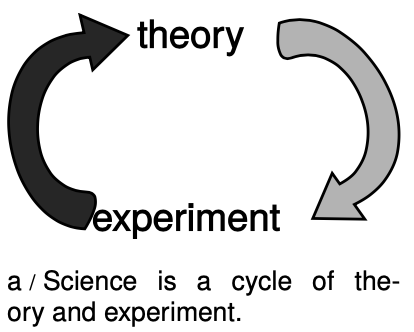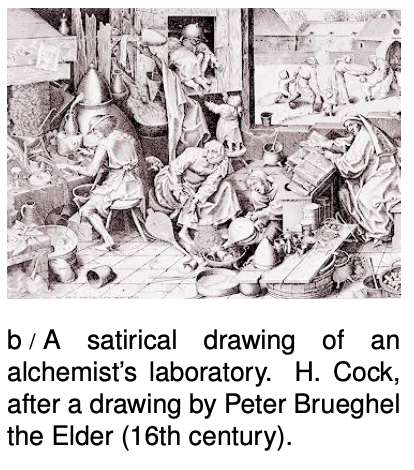LM 0.01 The scientific method Collection
Tags | |
UUID | 1e3116fe-f145-11e9-8682-bc764e2038f2 |
0.1 The Scientific method by Benjamin Crowell, Light and Matter licensed under the Creative Commons Attribution-ShareAlike license.
0.1 The Scientific method
Until very recently in history, no progress was made in answering [scientific] questions like these. Worse than that, the wrong answers written by thinkers like the ancient Greek physicist Aristotle were accepted without question for thousands of years. Why is it that scientific knowledge has progressed more since the Renaissance than it had in all the preceding millennia since the beginning of recorded history? Undoubtedly the industrial revolution is part of the answer. Building its centerpiece, the steam engine, required improved techniques for precise construction and measurement. (Early on, it was considered a major advance when English machine shops learned to build pistons and cylinders that fit together with a gap narrower than the thickness of a penny.) But even before the industrial revolution, the pace of discovery had picked up, mainly because of the introduction of the modern scientific method. Although it evolved over time, most scientists today would agree on something like the following list of the basic principles of the scientific method:
 (1) Science is a cycle of theory and experiment. Scientific theories 1are created to explain the results of experiments that were created under certain conditions. A successful theory will also make new predictions about new experiments under new conditions. Eventually, though, it always seems to happen that a new experiment comes along, showing that under certain conditions the theory is not a good approximation or is not valid at all. The ball is then back in the theorists' court. If an experiment disagrees with the current theory, the theory has to be changed, not the experiment.
(1) Science is a cycle of theory and experiment. Scientific theories 1are created to explain the results of experiments that were created under certain conditions. A successful theory will also make new predictions about new experiments under new conditions. Eventually, though, it always seems to happen that a new experiment comes along, showing that under certain conditions the theory is not a good approximation or is not valid at all. The ball is then back in the theorists' court. If an experiment disagrees with the current theory, the theory has to be changed, not the experiment.
(2) Theories should both predict and explain. The requirement of predictive power means that a theory is only meaningful if it predicts something that can be checked against experimental measurements that the theorist did not already have at hand. That is, a theory should be testable. Explanatory value means that many phenomena should be accounted for with few basic principles. If you answer every “why” question with “because that's the way it is,” then your theory has no explanatory value. Collecting lots of data without being able to find any basic underlying principles is not science.
 (3) Experiments should be reproducible. An experiment should be treated with suspicion if it only works for one person, or only in one part of the world. Anyone with the necessary skills and equipment should be able to get the same results from the same experiment. This implies that science transcends national and ethnic boundaries; you can be sure that nobody is doing actual science who claims that their work is “Aryan, not Jewish,” “Marxist, not bourgeois,” or “Christian, not atheistic.” An experiment cannot be reproduced if it is secret, so science is necessarily a public enterprise.
(3) Experiments should be reproducible. An experiment should be treated with suspicion if it only works for one person, or only in one part of the world. Anyone with the necessary skills and equipment should be able to get the same results from the same experiment. This implies that science transcends national and ethnic boundaries; you can be sure that nobody is doing actual science who claims that their work is “Aryan, not Jewish,” “Marxist, not bourgeois,” or “Christian, not atheistic.” An experiment cannot be reproduced if it is secret, so science is necessarily a public enterprise.
As an example of the cycle of theory and experiment, a vital step toward modern chemistry was the experimental observation that the chemical elements could not be transformed into each other, e.g., lead could not be turned into gold. This led to the theory that chemical reactions consisted of rearrangements of the elements in different combinations, without any change in the identities of the elements themselves. The theory worked for hundreds of years, and was confirmed experimentally over a wide range of pressures and temperatures and with many combinations of elements. Only in the twentieth century did we learn that one element could be transformed into one another under the conditions of extremely high pressure and temperature existing in a nuclear bomb or inside a star. That observation didn't completely invalidate the original theory of the immutability of the elements, but it showed that it was only an approximation, valid at ordinary temperatures and pressures.
self-check:
A psychic conducts seances in which the spirits of the dead speak to the participants. He says he has special psychic powers not possessed by other people, which allow him to “channel” the communications with the spirits. What part of the scientific method is being violated here?
(answer in the back of the PDF version of the book)
The scientific method as described here is an idealization, and should not be understood as a set procedure for doing science. Scientists have as many weaknesses and character flaws as any other group, and it is very common for scientists to try to discredit other people's experiments when the results run contrary to their own favored point of view. Successful science also has more to do with luck, intuition, and creativity than most people realize, and the restrictions of the scientific method do not stifle individuality and self-expression any more than the fugue and sonata forms stifled Bach and Haydn. There is a recent tendency among social scientists to go even further and to deny that the scientific method even exists, claiming that science is no more than an arbitrary social system that determines what ideas to accept based on an in-group's criteria. I think that's going too far. If science is an arbitrary social ritual, it would seem difficult to explain its effectiveness in building such useful items as airplanes, CD players, and sewers. If alchemy and astrology were no less scientific in their methods than chemistry and astronomy, what was it that kept them from producing anything useful?
Discussion Questions
Consider whether or not the scientific method is being applied in the following examples. If the scientific method is not being applied, are the people whose actions are being described performing a useful human activity, albeit an unscientific one?
A Acupuncture is a traditional medical technique of Asian origin in which small needles are inserted in the patient's body to relieve pain. Many doctors trained in the west consider acupuncture unworthy of experimental study because if it had therapeutic effects, such effects could not be explained by their theories of the nervous system. Who is being more scientific, the western or eastern practitioners?
B Goethe, a German poet, is less well known for his theory of color. He published a book on the subject, in which he argued that scientific apparatus for measuring and quantifying color, such as prisms, lenses and colored filters, could not give us full insight into the ultimate meaning of color, for instance the cold feeling evoked by blue and green or the heroic sentiments inspired by red. Was his work scientific?
C A child asks why things fall down, and an adult answers “because of gravity.” The ancient Greek philosopher Aristotle explained that rocks fell because it was their nature to seek out their natural place, in contact with the earth. Are these explanations scientific?
D Buddhism is partly a psychological explanation of human suffering, and psychology is of course a science. The Buddha could be said to have engaged in a cycle of theory and experiment, since he worked by trial and error, and even late in his life he asked his followers to challenge his ideas. Buddhism could also be considered reproducible, since the Buddha told his followers they could find enlightenment for themselves if they followed a certain course of study and discipline. Is Buddhism a scientific pursuit?
0.1 The Scientific method by Benjamin Crowell, Light and Matter licensed under the Creative Commons Attribution-ShareAlike license.
Calculators and Collections
- Comments
- Attachments
- Stats
No comments |
